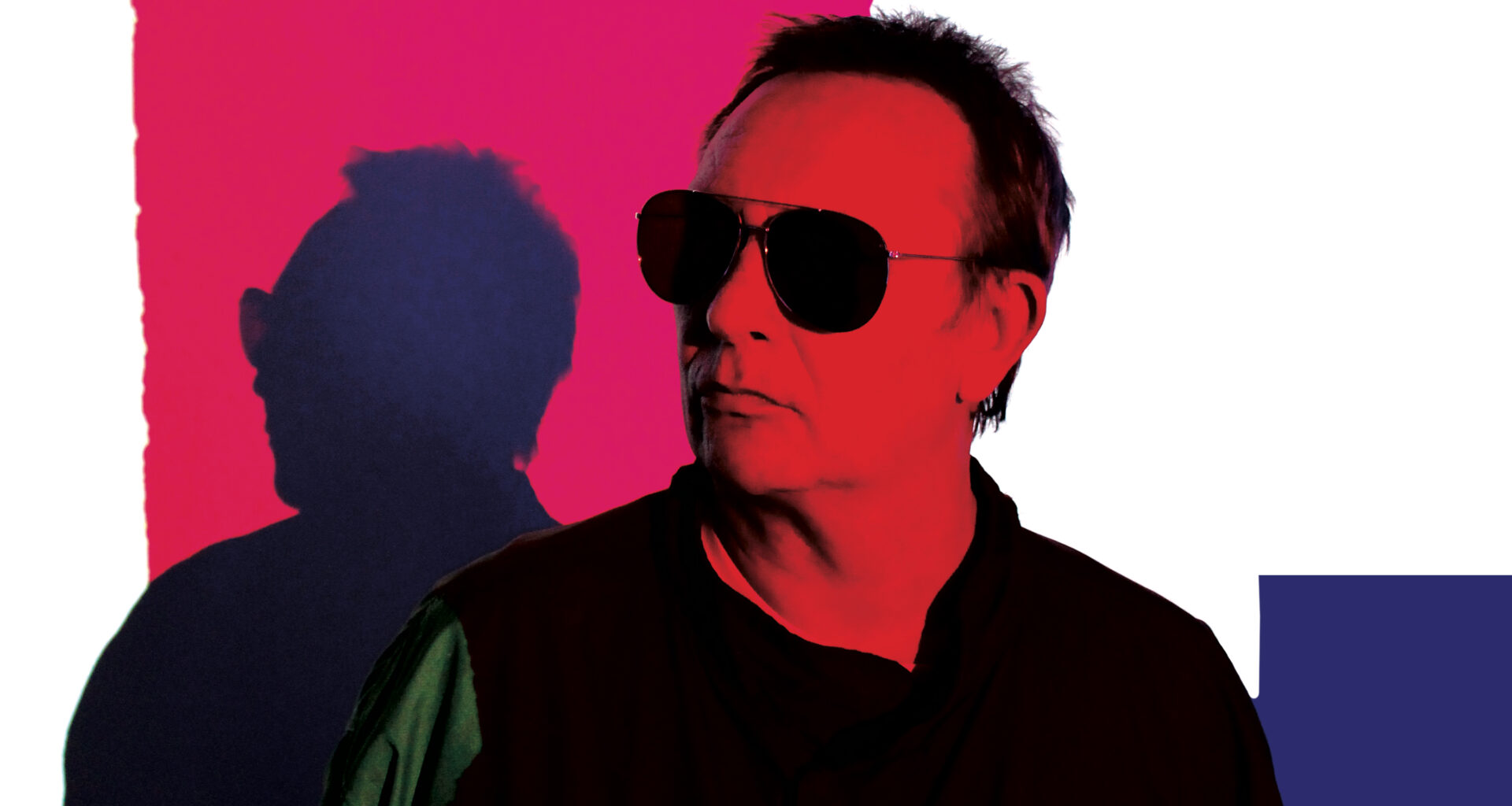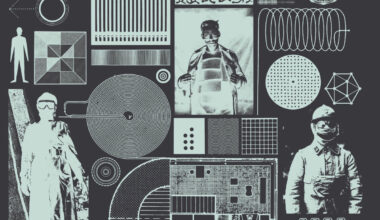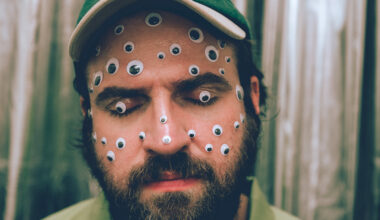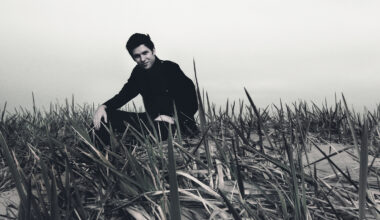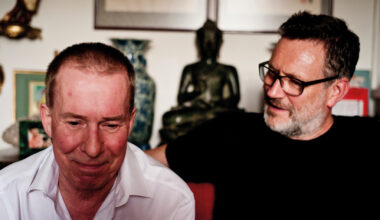It’s been nearly 30 years since Stephen Mallinder was last involved with Cabaret Voltaire, the act his name will always be associated with. Throughout that time, he’s never stopped creating, innovating and pushing forward, but his story isn’t as front and centre as you might expect. It’s time for an adjustment…
You find us in the Grand Parade Cafe & Canteen at Brighton University’s City campus. The seaside is just down there and a short stroll that way is the city centre. On the other side of the floor-to-ceiling windows, the quadrangle is starting to fill with the lunchtime hubbub of students.
Some of them will be on the Digital Music and Sound Arts degree course, one of the tutors of which is Stephen Mallinder. That’ll be Dr Mallinder to you. His PhD thesis, ‘Movement: Journey Of The Beat’, addresses “the trajectory and transition of popular culture through the modality of rhythm”. He’s also written academic papers and articles tackling subjects like the music of second-tier cities, the night-time economy, collaborative soundscapes, and the changing perceptions of music practices. It’s unusual to find such an influential artist deconstructing their own work and experiences in this rigorous way. But then Mallinder is not your usual anything.
Oh, and he has a new solo album on the way too, ‘Tick Tick Tick’, which is why I am here. But there’s some ground to cover before we get to that. And pretty much none of it is going to be what you expect.
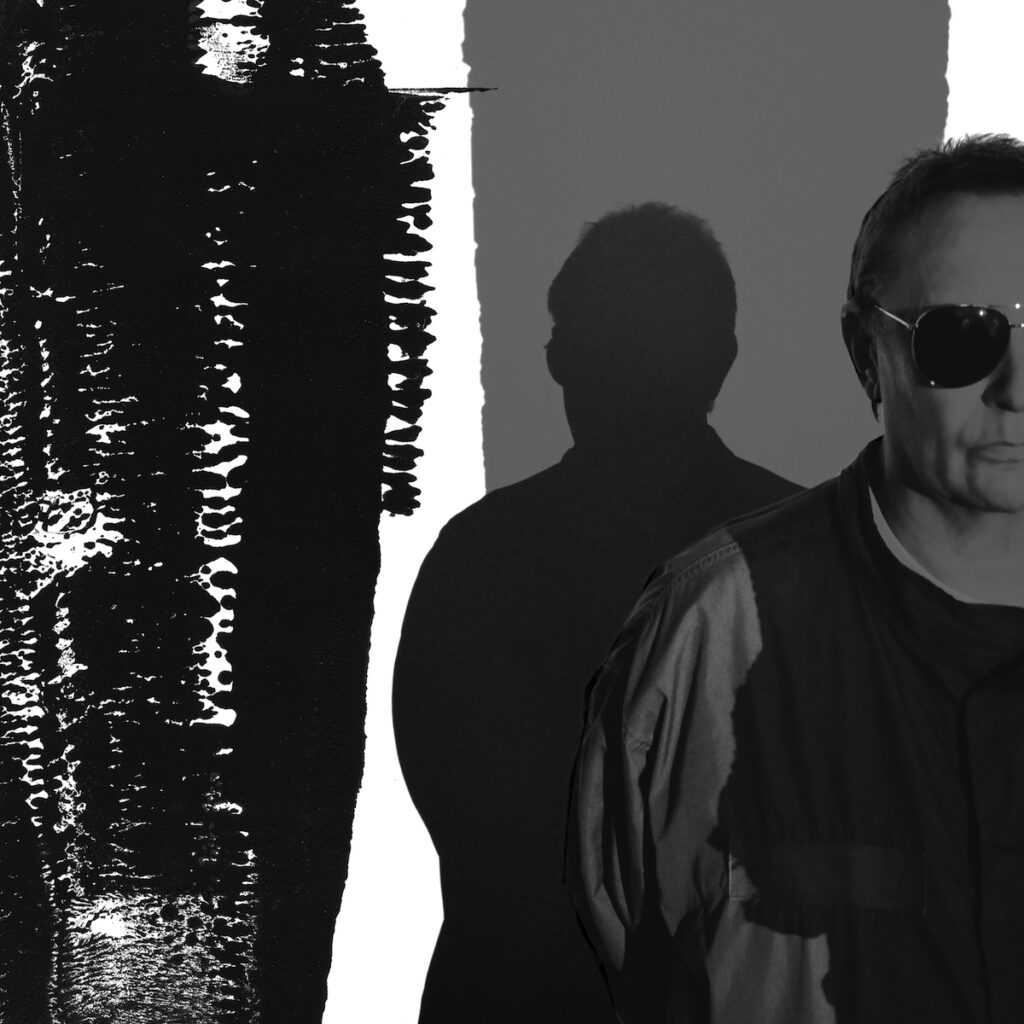
The tale of Cabaret Voltaire is a path so well-trodden that we’ve had the paving slabs replaced several times. But what happened next, when Stephen Mallinder and Richard H Kirk went their separate ways, isn’t a route that’s travelled very often.
“It was planned,” asserts Mal, as most people call him. “I spoke to Richard when I knew my second child was on the way and said, ‘I’m going to need to take a break. This can sustain one person, but not two, particularly as this one here will soon have two kids’. So it was agreed.”
Mal and Kirk would work on a final album, ‘The Conversation’, which came out in 1994, and then Cabaret Voltaire were no more.
Kirk’s side of the story is perhaps better known. He continued to put out head-turning work with a tsunami of releases under a mountain of pseudonyms – chief among them Sandoz and Electronic Eye. In 2009, with Mal’s blessing but not his participation, Kirk rebooted Cabaret Voltaire, remixing an album by New Zealand dub rock group Kora and collaborating with South Yorkshire outfit The Tivoli.
With a set of entirely new material, Kirk appeared at the Berlin Atonal festival in 2014 to perform the first Cabs live show in 20 years. In November 2020, an album arrived, the excellent ‘Shadow Of Fear’, the first Cabs release in 26 years. And then, in September 2021, just as Cabs 2.0 was building a head of steam, Richard H Kirk died, aged 65.
A renegade and a maverick, the uncompromising body of work Kirk has left behind, both with Cabaret Voltaire and in his own right, is almighty. Single-minded and resolute, he went his own way and continued to invent and reinvent right until the end.
His old friend since their Sheffield schooldays, the man sitting across from me at the canteen table couldn’t be more different. While they share the same genes when it comes to innovation, creativity and progression, where Kirk was a lone wolf, Mal is an enabler, a facilitator, a serial collaborator. He not only wants to share his thoughts, his experiences and his know-how, you get the feeling he needs to.
“That’s the way that it always was for me,” he says. “Most art involves a co-operative aspect. Cabaret Voltaire was a collection of things that made it Cabaret Voltaire. It wasn’t just me and Richard and Chris Watson. It was constructed through so many other parts – from designers to labels to audiences – who all fed into what we were. It was a working art project.”
The Digital Music and Sound Arts degree is based in a classic 1960s multistorey block, recognisable to anyone who has been to art school in the last half-century. Indeed, the creative provision in Brighton is steeped in history, stretching back to 1859, when one of Britain’s earliest art schools opened at the nearby Royal Pavilion.
My morning is spent tagging along with Mal as he does the rounds, like a doctor. A disco doctor. We flit in and out of recording studios, workshops and live spaces, the echoey corridors and staircases buzzing with students, many of them getting ready for their final year degree shows, while passing colleagues briefly stop for a chat and a joke.
In one lab, we find a pile of children’s electronic toys with the guts ripped out of them, their sound cards being hacked for making very different sorts of noise. We crash an MA tutorial and meet a student who has been working on a concept using the massive reverb in the disused oil tanks at the Inchindown Fuel Depot, an abandoned military storage facility near Invergordon in the Scottish Highlands.
It seems slightly incongruous that this course exists alongside fine artists, illustrators, sculptors and printmakers. So my first question is, what exactly is a Digital Music and Sound Arts degree?
“It’s an art course… but with sound,” explains Mal as we head for the canteen. “Our second-year students are currently doing group work, for example, and we’ve got one lot using a corridor with speakers in the ceiling to create linear sound. There are groups working on spatialisation, immersive sound, resonance, and creating a performance with shortwave radio.”
You can see why he is at home here. The ideas flying around aren’t far off the sort of thinking evident in the loft of Chris Watson’s house in Sheffield at the dawn of Cabaret Voltaire. Our perception of Stephen Mallinder is one thing, but are the students aware of him and his work when they arrive here?
“I do get a few saying, ‘Can me dad have your autograph?’,” admits Mal as we settle down with our sandwiches. “But I don’t make anything out of it. After a while, I think they know that I’ve got some history. It becomes part of the conversation, because obviously the point of me being here is to bring some of that into what I do.”
You’ve never been tempted to pull the old “Don’t you know who I am?” line?
“I’ve always tried to avoid that,” he insists, his face breaking into a smile. “They should take me for who I am, not for who I think I am.”
Not for the last time today, he dissolves into raucous laughter.
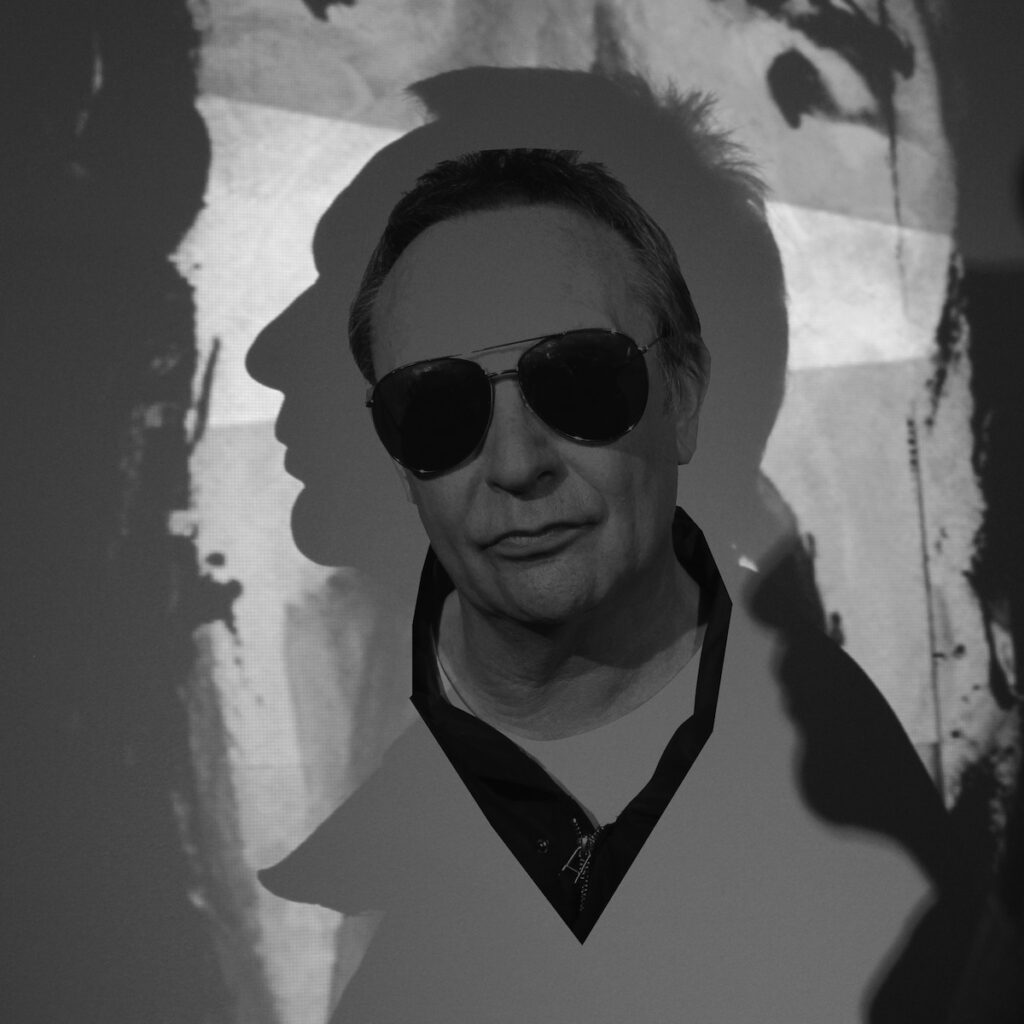
Looking back in order to move forward is what all good art courses should do. Having Mal attached to the Brighton course – sharing his knowledge and experience, giving back, motivating others – is how work like this thrives. But how did Mal’s own journey into sound begin? Who handed him the batons?
“My education came from my family’s record collection and from their interest in music,” he says. “My dad died when I was four, so I never knew him, but he played violin. And my auntie played piano. I come from a massive family, there are loads of us, so at Christmas and at parties my auntie would be banging out the show tunes. The music seeped through us.
“My two older sisters were both important in terms of my musical education too. We didn’t own many records because we were quite poor – my mum was a dinner lady and she brought up three kids on her own. Music was something other people bought, but I listened to. The first record I remember – and fuck knows why we had it – was John Leyton’s ‘Johnny Remember Me’, produced by Joe Meek. I didn’t know who Meek was, I was only eight or nine, but I got that there was this strange, electronic kind of vibe going on there.”
The magical world of radio also played a significant role in his formative years. His sisters listened to the latest pop hits on Radio Luxembourg, with tracks like The Tornados’ ‘Telstar’ – another Joe Meek production – catching Mal’s young ears.
“We had a radiogram in the front room,” he says. “It looked like an eagle and it was all walnut, with this exotic tuning dial and a speaker in the middle. It had these lovely rich bass tones. It was beautiful.”
The radio would generally be tuned to the BBC Light Programme, the national station that eventually became Radio 1 and Radio 2. On Saturday mornings, there was a show specifically aimed at children (‘Children’s Choice’, later renamed ‘Junior Choice’).
“The record they played that really got me was called ‘Sparky’s Magic Piano’,” recalls Mal. “It’s about a kid learning to play the piano and the instrument starts talking to him in a voice that sounds like this primitive vocoder, which was very eerie. Those connections – of radio, electronics and spooky noises – must have been imprinted on me when I was quite little.
“And then, when I was about 12 or 13, I started living through my brother-in-law’s record collection. He had Johnny Cash’s live album, ‘Johnny Cash At Folsom Prison’, and the Jacques Loussier Trio and Thelonious Monk. The records I particularly liked were split seven-inch EPs with Chuck Berry on one side and Bo Diddley on the other. I fucking loved Bo Diddley and his railroad rhythms.”
He doesn’t remember getting his own radio (he thinks he inherited an old transistor set along the way), but he can clearly recall his mum buying him a tape recorder.
“Do you know what I used to do with it?” he asks with a grin. “I used to play Subbuteo with my cousin and we’d record ourselves commentating.”
It wasn’t long before he put his ability to record whatever he liked to better use. As he got older, a whole world of music opened up via the radio and the television – BBC studio sessions from Alexis Korner and live sets by Captain Beefheart on ‘The Old Grey Whistle Test’. Getting into actually making it took another leap of imagination, though.
“You were either being formally taught to read music or you had mates you could play with. That’s what I did with Richard and Chris. But it wasn’t like, ‘My mate’s a bass player, my other mate’s a drummer, I’m a keyboard player… hey, we’ve got a band!’. The big thing for us was seeing Brian Eno with Roxy Music on TV and he was using a Revox as an instrument. We thought, ‘You can use a tape machine as an instrument?’.”
And Eno looked mental.
“Well, that’s why punk happened,” declares Mal. “Roxy represented this whole other dimension of what music could be.”
From the railroad rhythms of Bo Diddley, which Mal would go on to write about in his thesis, to the vocoded voice on ‘Sparky’s Magic Piano’ and the otherworldly productions of Joe Meek, to the blues of Alexis Korner and on to Brian Eno wigging out with his Revox, Cabaret Voltaire were born on radio waves and TV signals.
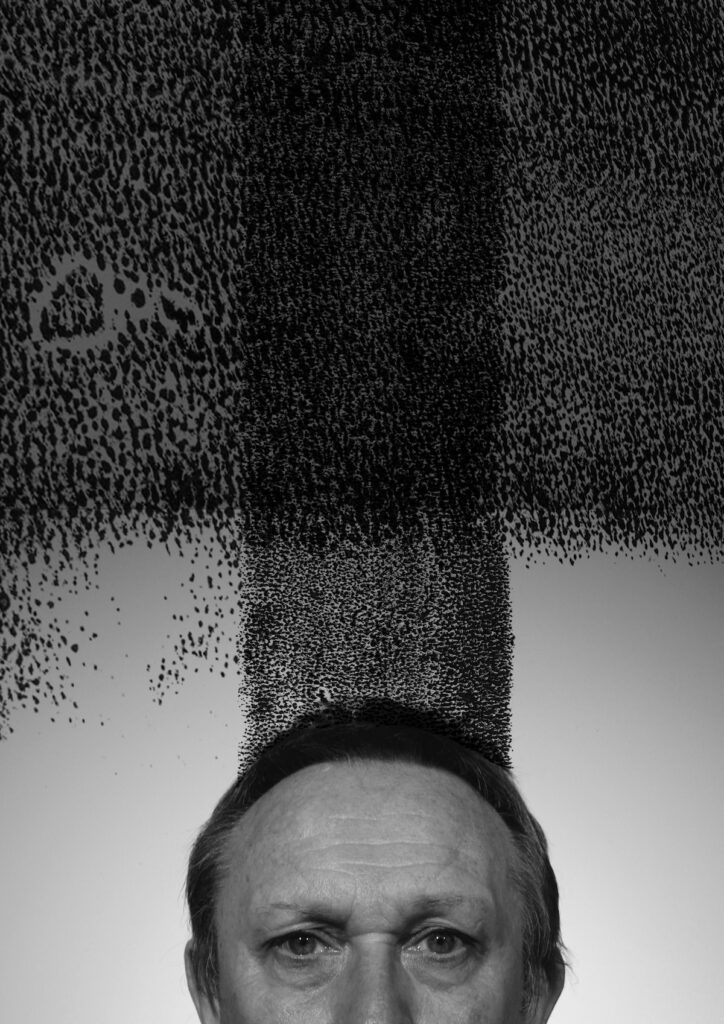
Righto. Let’s take a breather. Usually at this point you’d expect a deep dive into the Cabaret Voltaire legend. Not this time. We’re skipping all that.
You rejoin us near where we came in. For Mal, the Cabs stopped in 1994. For many, he would only reappear in 2012, collaborating with Fila Brazillia’s Steve Cobby as Hey, Rube! before forming Wrangler with Ben “Benge” Edwards and Tunng’s Phil Winter. Which leaves us with a hiatus of almost two decades.
“After the recession in 1991, it became harder for us to make money as the Cabs,” reflects Mal as he begins to fill in the missing years. “Everything was starting to feel a bit strange musically – it was all house music and instrumental ambient stuff… and I wasn’t sure what my place was in that. I knew I didn’t want to just keep doing what we’d been doing forever, but I was worried about my kids, I was worried about money, and I realised I had to do something else because I couldn’t afford to live like that. And certainly not in London. So I had to make a move.”
He was Mal from the Cabs, but there was no longer any Cabs for him to be Mal from. So what now?
“The choices we had as a family were to move back to Sheffield or fuck off completely,” he confides. “And I didn’t want to go to Sheffield. I still spend loads of time there, and I love it, but at the time it was just… I don’t think Richard would have liked it if I’d moved back. We’d been to Oz for a holiday a couple of times because my wife, my first wife, was Australian, so I suppose the idea of disappearing out there worked.”
Didn’t the thought of a move like that feel a bit like a defeat?
“I think it was just a fear of not knowing how to take that next step,” he says. “Whatever I did, it felt as though I’d be visible.”
Like people were waiting for your next move?
“Making music all those years and then going, ‘Well, I’ve got to do something else now’, was really hard to come to terms with,” he admits. “I didn’t know how to deal with it. If I was going to reinvent myself, which I thought I needed to do, it would be harder in England. Whereas the invisibility of Australia meant I could do it there with much less pressure. So I ran away.”
In 1995, his family moved to Perth, on the west coast of Australia, where Mal could start again – personally, professionally and creatively. There was only one problem…
“Did I have a plan?” he asks, repeating my question. “Not really, no. I wanted to do some studying, so I trained as a schoolteacher. But to be a teacher over there, your first job had to be out in the bush. By the time I qualified, I’d been in Australia for a year. I was making music again and I had started doing a bit of radio. So it was like, ‘I’m not going to pack this in to go and work in the bush’.”
Out of interest, what would Mr Mallinder have taught?
“Maths,” he says, before letting out a huge laugh. “I was shit at maths, but they needed maths teachers.”
With thoughts of teaching canned (for now), he became increasingly involved in his local arts radio station in Perth, RTRFM, where he became a producer.
“I worked on the morning programmes, covering politics, art and technology,” he tells me. “After a while, I asked if I could have a show of my own. I had to earn my stripes, so I did the graveyard shift for a year on a show called ‘The Ambient Zone’.”
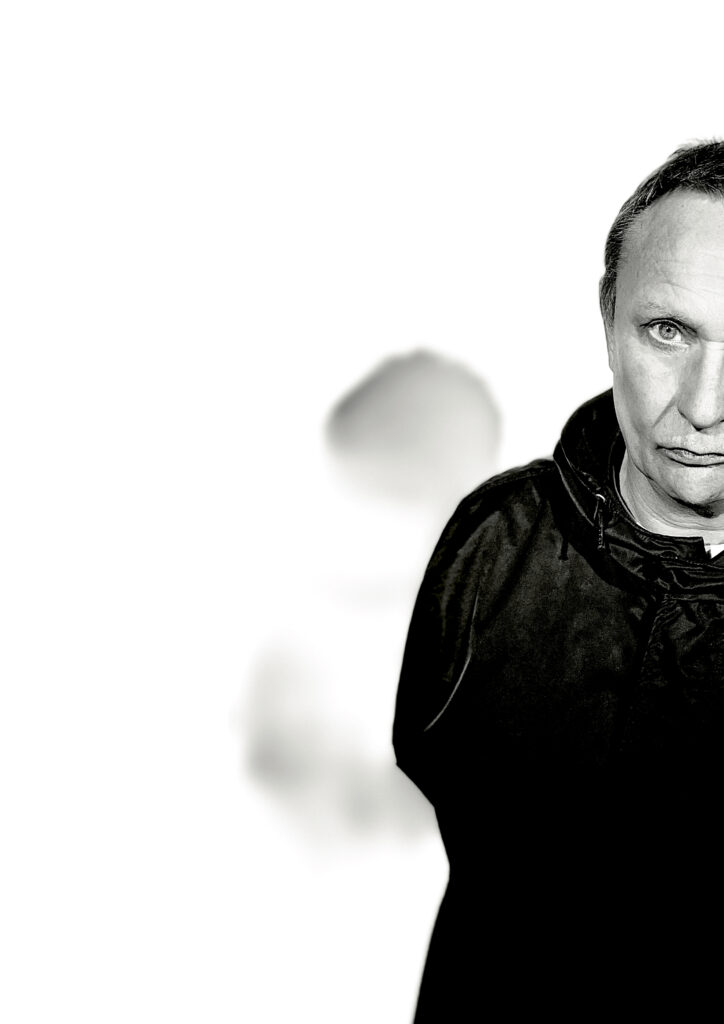
Why radio? Well, of course, we’ve already been there. Whether it was the BBC Light Programme, or the Top 30 singles chart on Radio Luxembourg, or John Peel on Radio 1 – Monday to Thursday, 10pm to midnight – all that possibility floating in on the ether and filling young minds is dizzying.
The first time I heard Cabaret Voltaire was on John Peel, my little transistor set tucked under my pillow in age-old fashion, ‘Sluggin’ Fer Jesus (Part One)’ coming in like, well, the railroad rhythms of Bo Diddley, with the ghostly voice of the evangelical preacher riding on top. I know I’m repeating myself, but Cabaret Voltaire were born on the same radio waves I heard them on for the first time. It makes my head spin. Anyway, back to Mal…
“I ended up doing another show on RTRFM which was pretty successful,” he continues. “It was a drive-time electronic music show called ‘Full Frequency’. I did it for nine years.”
It’s still going today (not with Mal, obviously) on weekdays from 3pm to 5pm. You can tune in online. But here’s the thing about Mal’s stint in the presenter’s chair. When artists arrived on tour in Perth, which they did on a regular basis, they were asked if they wanted a spot on the local arts radio station, you know, to talk up their gig.
“Anyone who was passing through, they all used to come in,” he beams. “Loads of the house guys, the techno guys. And the Cabs have that influence across house, techno, hip hop, so when they arrived they were like, ‘Oh, fucking hell, it’s Mal off the Cabs’.”
Running away had turned into landing on his feet. With Richard Kirk buzzing away in his Sheffield HQ, his old partner in crime was also embarking on exciting new adventures. Only he was doing it thousands of miles away and no one seemed to notice.
“I set up a label called Off World Sounds,” he says. “We put out 30-odd releases and we had this live production company doing some big gigs, shows with 20,000 people. I was making a lot of music too.”
Mal formed Sassi & Loco with Travis Calley, the keyboard player from Yummy Fur, a Perth band he’d met when he produced them. There was also Ku-Ling Bros, a project with Shane Norton, whose work as Soundlab he picked up for his label. He released several compilations as well, featuring artists from the vibrant local electronic scene, a scene that seemed to have galvanised around Mal. Of course.
“I originally started Off World Sounds because I needed an outlet for Sassi & Loco,” he notes. “But I liked the idea of a label and I wanted to use it to work with other people. I love that idea of communities and connections and building these cultures.”
He ran OWS with Pete Carroll, who he knew from Manchester. Pete is the brother of Pat and Matt Carroll of Central Station Design, who were responsible for the look of Factory’s second wave, creating record covers and posters for Happy Mondays, Black Grape, James and more. The Mondays’ iconic ‘Madchester’ artwork was one of theirs. The Carrolls also had Shaun Ryder for a cousin.
“Pete washed up in Australia a few years before I did,” explains Mal. “He was one of the heads of Sony out there, but when I arrived he was way more interested in doing the label with me.”
While poking through the imprint’s back catalogue, I found a record that I love, but I’d had no idea it was on OWS. Amateur Night In The Big Top’s self-titled album was released in 2003 and came complete with a sticker that read, “Introducing Shaun William Ryder – an original”. Copies of the CD are currently shifting for £3 on Discogs. You can thank me later.
“Shaun came over to Oz to try and clean himself up,” says Mal. “He was in quite a rough way. He was in a different space, dealing with a bad drug habit, and we made an album with him almost as therapy. We did a lot of it in Pete’s garage. We would have to wait until three in the morning, usually after Shaun had had a pint of sherry, then we’d record him telling stories and doing his vocals. But he’s Shaun – he brushes himself down… he’s a survivor.”
So how did Mal go from radio show host, label big cheese and live promoter in Australia to lecturing at Brighton University back in the UK?
“Well, there is this wonderful person, a cultural academic called Professor Tara Brabazon, and she worked at one of the universities in Australia,” he reveals. “She used to love my radio show, which is how we met. I was talking about writing a book and she said, ‘Why don’t you write a thesis?’. She said, ‘You can turn the PhD into a book and I can get you some funding to buy you the time to write it’.”
Which is exactly what he did.
“I’d written two-thirds of it when Tara became Professor of Media here at Brighton. By that point, we had written a few academic papers together and she wanted me to come over to the UK so we could use my research. I came back for a year in 2007 and I’ve been here ever since.”

The ideas that Mal nurtured Down Under are still very much in evidence in his work today. Wrangler are a collective based around Benge’s MemeTune Studios in Cornwall and they draw John Grant into their orbit for their Creep Show offshoot. What’s more, Mal’s manager, Steve Malins, looks after an impressive stable of similarly self-starting and self-sufficient artists, including John Foxx, Hannah Peel, Blancmange and Gazelle Twin.
Many of these artists cross-pollinate. Benge and Peel are both in John Foxx And The Maths, while Mal is currently preparing to go on tour supporting Blancmange. You won’t be surprised to learn that ‘Off World Sounds: Building A Collaborative Soundscape’, an article Mal wrote with Tara Brabazon for the Journal Of Media And Culture in 2006, expands on this thinking.
Mal’s third solo album, ‘Tick Tick Tick’, is also a product of the collective. Written at his home in Brighton, it was recorded at MemeTune. It follows 2019’s ‘Um Dada’, which in turn was a rather tardy turnaround from his debut solo outing, ‘Pow-Wow’, which came out in 1982.
Three solo albums in, you know, a million years. That’s pretty slack.
“It’s rubbish really, isn’t it?” laughs Mal. “What have I been doing all this time?”
If you need a peg to hang your coat on, ‘Tick Tick Tick’ is in the ballpark of Cabaret Voltaire’s ‘Micro-Phonies’ or ‘The Covenant, The Sword And The Arm Of The Lord’. It has an electro feel and utilises those same kinds of sounds, but it’s way less abrasive. The mid-80s Cabs had the funk going on. Here, Mal adds the soul.
‘Shock To The Body’ is a killer floorfiller, with machines firing on every cylinder, pinging all over the place, while ‘Hush’ seems instantly familiar. The melody is infectious, the rich and relaxed bassline locking into an off-kilter groove while hi-hats, handclaps and assorted percussion rattle away. There’s a real warmth and charm in Mal’s solo work. How would he describe his sound?
“There’s a level of understatement and subtlety and a little wonkiness in there,” he muses. “I’m subconsciously the sum of so many things and I suppose the solo records are just how all that manifests itself.”
What makes a release a Stephen Mallinder solo album? Three in nearly 40 years suggests it’s a special occasion. What prompts him to get to work?
“I don’t go into a big sort of, ‘Right, I want to make a Stephen Mallinder record’,” he says. “I make music all the time, but I’ve always been reluctant to put my own name to things. Music has a social component… we don’t create in isolation. I enjoy doing my own stuff, but I love the process of working with other people, so I’ve never really felt the need to go, ‘Oh, this is me’.”
While I get that other people are inevitably involved along the way with everything Mal does, I’m intrigued by his hesitancy in taking the credit where credit is due.
“Benge worked with me on the production for ‘Tick Tick Tick’ and ‘Um Dada’, but I’m the one saying, ‘This is what I want to do, this is how I want to take it’,” he offers. “When I’m with Wrangler or Creep Show, it’s all up for negotiation. But even if you’re making music on your own, you don’t exist in a vacuum. You’re influenced by so many things. In my case, it draws on my past, on the people I’ve worked with, on everything I’ve listened to and seen. It’s always a composite and you’re just the tip of the iceberg.”
So what makes up the ‘Tick Tick Tick’ iceberg?
“With this and ‘Um Dada’, I went in with the same idea,” he says, a broad smile beginning to break out in anticipation of his next statement. “Finding somewhere on the spectrum between The Jackson 5 and Terry Riley. That was it.”
I only have to raise my eyebrows.
“The Jackson Five? Well, it could have been The Brothers Johnson, I could’ve gone for anything really, but I think it was about weirdness and joy at the same time. The album explores minimalism and the ideas of repetition, groove and syncopation. That and somehow marrying the characteristics of electronic sound with the bedrock of rhythmic music.”
And the non-scholarly explanation?
“It’s got basslines and disco beats and things,” he grins.
Things like cowbells?
“There is a cowbell on every track,” he confesses. “I’m not a massive fucking snare kind of guy, but I do love percussion. I love a clap, but there’s something about a cowbell. It has a natural groove that carries a rhythm without it being overt.”
Did you have to rein yourself in at any point?
“No, no, no,” he says, shaking his head slowly. “It became a bit of an in-joke by the end, but there is no such thing as too much cowbell. It is quite discreet and on certain tracks you sort of go, ‘I don’t know if there’s a cowbell in there…’, but there is.”
Anything else in the mixing pot you’d care to share while we’re at it?
“I was going for that Arthur Russell vibe. I love his stuff, I love that it has a natural groove. There’s a lightness and a flow, with his voice gliding and flittering above. But there was no individual template for this album. We live in a world where we just skim and everything is like a smorgasbord of music. The days when you’d go, ‘I heard The Velvet Underground, so I want to be like The Velvet Underground’, are gone. It’s like a whole series of dots… and each time we join them together, we draw a different picture. On this occasion, these are the dots that I used.”
And what did you draw?
“I wanted to keep a connection to Detroit and techno, to Moodymann and people like that. I was also listening to bits of vaporwave and lots of dubstep.”
Vaporwave? That’s interesting.
“‘Hush’ and ‘Wasteland’ started off very vaporwave. We were recording instruments and then slowing everything down. The tracks didn’t end up as vaporwave, but they started off in that languid way.”
He mentions that ‘Tick Tick Tick’ is a more personal record, noting that the lyrics are perhaps closer to his own experiences than would be the case for a shared project.
“I think they are,” he says. “I’m writing very broadly about societal implications. They’re quite minimal, just sentiments of the daily trials, the everyday struggles. I also tried to sneak a few cultural and literary references in. I got Franz Kafka and JG Ballard in there.”
Is there, I wonder, a difference between the work of solo Mal and collaborative Mal? Are his solo albums perhaps the introvert side of him and his partnerships the extrovert?
“I’m not a particularly loud person when I’m on my own,” he confirms. “I’m much louder and more bombastic when I’m with other people.”
So does writing and recording with Wrangler or Creep Show ever mean he has to fight for oxygen in the room?
“There are times when it feels like there’s a tension,” he replies. “In a good way, though. And there are other times when we just let it flow. We are quite loose with each other. In Creep Show, with both John and myself doing vocals, we find ways of making that work. He’s got a far more astute idea of where he’s going, so I’ll often let him roll with it, and there are times when he lets me roll with it.”
Earlier on, as my train was pulling into Brighton station, Mal sent me a text.
“Morning, I’m here, outside Superdrug,” it said. I resisted the temptation to text back, “The glamour!”.
Stephen Mallinder has been at the forefront of experimental electronic music for more than four decades, his name is synonymous with groundbreaking innovation, and he’s waiting for me outside Superdrug. The thought makes me laugh, but I’ve known him for a while and he’s just Mal doing what Mal does.
Like me, John Grant grew up with the sound of Cabaret Voltaire ringing in his ears. If you’ve seen Creep Show play live, you’ll know that his face says, “I can’t quite believe I’m here, it’s like I’m in Cabaret Voltaire”. To Mal, that doesn’t figure. He seems unaware of the sort of clout he carries.
“When Creep Show played at Sensoria for the first time a couple of years ago, John was buzzing,” says Mal. “It was like, ‘He knows this, he really knows this’. I’d never actually stopped and thought about what I might mean to other people with what I’ve done. I guess John is a living embodiment.”
And that’s what you did, I point out.
“I know,” he says, nodding and taking it in for a few moments. “It’s quite special, isn’t it? It’s like, ‘Oh, wow, it wasn’t all just a waste of time’.”
‘Tick Tick Tick’ is out on Dais
